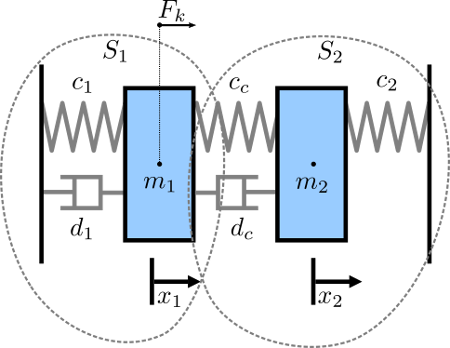Mass Spring Damper
Overview
The mass spring damper digital twin (DT) comprises two mass spring dampers and demonstrates how a co-simulation based DT can be used within DTaaS.
Example Diagram

Example Structure
There are two simulators included in the study, each representing a mass spring damper system. The first simulator calculates the mass displacement and speed of for a given force acting on mass . The second simulator calculates force given a displacement and speed of mass . By coupling these simulators, the evolution of the position of the two masses is computed.

Digital Twin Configuration
This example uses two models and one tool. The specific assets used are:
| Asset Type | Names of Assets | Visibility | Reuse in Other Examples |
|---|---|---|---|
| Models | MassSpringDamper1.fmu | Private | Yes |
| MassSpringDamper2.fmu | Private | Yes | |
| Tool | maestro-2.3.0-jar-with-dependencies.jar | Common | Yes |
The co-sim.json and time.json
are two DT configuration files used for executing the digital twin.
You can change these two files to customize the DT to your needs.
Lifecycle Phases
| Lifecycle Phase | Completed Tasks |
|---|---|
| Create | Installs Java Development Kit for Maestro tool |
| Execute | Produces and stores output in data/mass-spring-damper/output directory |
| Clean | Clears run logs and outputs |
Run the example
To run the example, change your present directory.
If required, change the execute permission of lifecycle scripts you need to execute, for example:
Now, run the following scripts:
Create
Installs Open Java Development Kit 17 in the workspace.
Execute
Run the the Digital Twin. Since this is a co-simulation based digital twin, the Maestro co-simulation tool executes co-simulation using the two FMU models.
Examine the results
The results can be found in the /workspace/examples/data/mass-spring-damper/output directory.
You can also view run logs in the /workspace/examples/digital_twins/mass-spring-damper.
Terminate phase
Terminate to clean up the debug files and co-simulation output files.
References
More information about co-simulation techniques and mass spring damper case study are available in:
The source code for the models used in this DT are available in mass spring damper github repository.